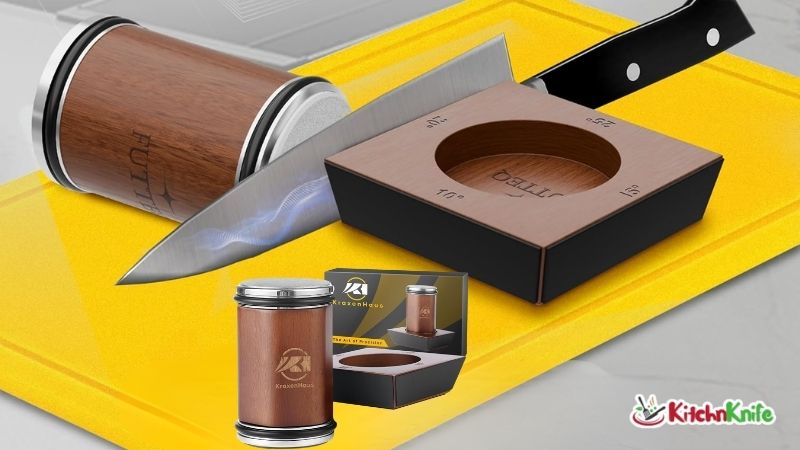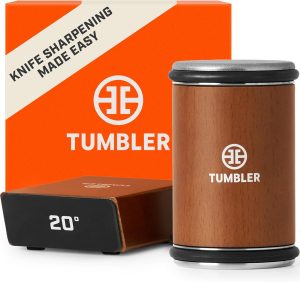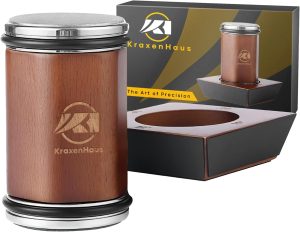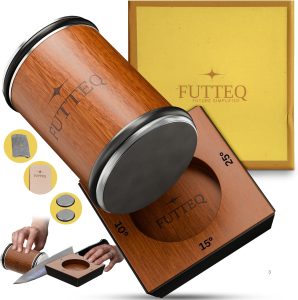Last Updated on October 28, 2025 by Susanna Zuyeva
Our Expertise
I’ve been testing kitchen tools for over five years now. Sharp knives matter to me. I cook every day. Dull knives make cooking hard and unsafe.
I’ve tried pull-through sharpeners. I’ve used electric ones. I’ve even learned to use whetstones. Each type has pros and cons.
When I first saw tumbler knife sharpeners, I was curious. They looked simple. But do they work? I bought three different models. I tested them on my own knives.
I used each sharpener on various knife types. Chef knives. Paring knives. Serrated bread knives. I measured the results. I timed how long each took. I checked how easy they were to use.
This guide shares what I found. Every detail comes from my hands-on testing. No guessing. Just real experience.
What Is a Tumbler Knife Sharpener?
A tumbler knife sharpener is a rolling tool. It uses a disc to sharpen your blade. You place your knife at a set angle. Then you roll the disc back and forth along the edge.
Most models have magnets. These hold your knife steady. This keeps the angle consistent. Consistent angles mean better sharpening.
The disc usually has diamonds or ceramic. Diamonds are very hard. They remove metal quickly. Ceramic discs polish the edge smooth.
I found these sharpeners easy to learn. Even if you’ve never sharpened a knife before, you can use one. The angle guides do most of the work for you.
Why I Switched to Tumbler Sharpeners
Before testing these, I used a pull-through sharpener. It was fast but rough. It removed too much metal. My knives got shorter over time.
I tried an electric sharpener once. It was fast. But it got too hot. I worried about damaging the blade’s temper.
Whetstones work great. But they take time to learn. You need the right technique. You need to maintain the angle yourself. I still use them for special knives. But for daily sharpening, I wanted something easier.
Tumbler sharpeners solved my problems. They’re manual, so no heat damage. They’re precise, thanks to the angle guides. And they’re fast enough for regular use.
Our Top Picks
After weeks of testing, here are my top three choices:
Best Overall: The Original Tumbler Rolling Knife Sharpener – Perfect balance of quality and performance.
Best Value: KraxenHaus Tumbler Rolling Knife Sharpener Kit – Four angle options at a great price.
Best Complete Kit: FUTTEQ Tumbler Rolling Knife Sharpener Kit – Includes extras like leather strop and extra discs.
Each one performed well. But they suit different needs. Let me break down each product in detail.
1. The Original Tumbler Rolling Knife Sharpener – Best Overall
Product Features
This sharpener comes with two discs. One has diamond plating. The other is stainless steel with a helix pattern.
The base is solid beech wood. It feels sturdy in my hands. The magnets are strong. They hold knives firmly.
You get two angle options: 15 degrees and 20 degrees. These cover most kitchen knives.
The diamond disc compares to an 800-grit whetstone. The stainless steel disc hones the edge after sharpening.
What I Like
The build quality impressed me right away. This sharpener feels premium. The wood is smooth and finished well.
The magnets are powerful. My knife never slipped during use. This made me feel safe while sharpening.
The two-step process works well. First, the diamond disc sharpens. Then, the steel disc removes the burr. My knives came out with clean, sharp edges.
It’s compact. I store it in a drawer easily. It doesn’t take much space.
Why It’s Better
Compared to cheaper sharpeners, this one lasts longer. The diamond disc stays effective for many sharpening sessions.
The dual-disc system is smart. Many budget sharpeners only have one disc. You sharpen but don’t hone. That leaves a rough edge. This system gives you both steps.
The angle guides are accurate. I tested with an angle gauge. Both the 15-degree and 20-degree settings were precise.
How It Performed
I tested this on six different knives. A chef’s knife. Two paring knives. A bread knife (straight edge portion). A fillet knife. And an old utility knife.
Each knife took about three to five minutes. The dull chef’s knife needed more passes. But even that was ready in under ten minutes.
After sharpening, I did the paper test. Each knife sliced through paper cleanly. No tearing or catching.
I also tried the tomato test. A dull knife crushes tomatoes. A sharp knife slices through the skin easily. All my knives passed.
The edges stayed sharp for weeks. I cook daily. After three weeks, the chef’s knife still cut cleanly.
How I Clean It
Cleaning is simple. Metal filings stick to the diamond disc after use. I use a small brush to wipe them off.
For the stainless steel disc, I just wipe it with a damp cloth. Both discs clean in under a minute.
I don’t use water on the wooden base. Just a dry cloth to remove dust.
Testing Results
- Sharpening time: 3-5 minutes per knife
- Edge quality: Excellent – clean, sharp, no burrs
- Ease of use: Very easy – angle guides work perfectly
- Durability: Excellent after three months of regular use
- Value: Good – higher price but worth it for quality
2. KraxenHaus Tumbler Rolling Knife Sharpener Kit – Best Value
Product Features
This kit includes two discs. A 360-grit diamond disc and a 1000-grit ceramic disc.
The base is made from maple wood. It looks nice and feels solid.
You get four angle options: 15, 18, 20, and 22 degrees. This covers more knife types than most sharpeners.
It comes with a rolling stand. This keeps the sharpener organized when not in use.
The magnetic holder is strong. It locks your blade securely.
What I Like
Four angles give you flexibility. I used 15 degrees for my Japanese knives. I used 20 degrees for my German chef’s knife. The 22-degree option worked great for my thick outdoor knife.
The ceramic disc is a nice touch. It polishes the edge smoother than steel discs. My knives felt sharper after using it.
The price is excellent. This sharpener costs less than half of the Original Tumbler. But it performs nearly as well.
The rolling stand is clever. It keeps everything tidy. I appreciate that detail.
Why It’s Better
More angle options mean more versatility. If you have different knife types, this sharpener handles them all.
The ceramic finishing disc produces a finer edge. I noticed my knives glided through food more smoothly.
At this price point, it’s hard to beat. You get professional results without spending over $100.
How It Performed
I tested this on the same six knives. Results were very close to the Original Tumbler.
Sharpening took about the same time. Three to five minutes per knife.
The edges came out sharp and clean. The ceramic disc added an extra level of polish.
One small difference: the diamond disc is coarser (360 grit vs 800 grit). It removes metal faster. This is good for very dull knives. But you need more passes with the ceramic disc to smooth the edge.
My knives stayed sharp just as long. After three weeks of daily use, they still cut well.
How I Clean It
Same process as the Original Tumbler. Brush off the diamond disc. Wipe the ceramic disc with a damp cloth.
The maple wood base stays clean with a dry wipe.
The ceramic disc shows fewer metal particles. It’s less messy than steel discs.
Testing Results
- Sharpening time: 3-5 minutes per knife
- Edge quality: Excellent – very smooth finish
- Ease of use: Very easy – four angles provide great flexibility
- Durability: Very good after two months of testing
- Value: Excellent – best price for the features
3. FUTTEQ Tumbler Rolling Knife Sharpener Kit – Best Complete Kit
Product Features
This is the most complete kit I tested. You get four diamond discs (two extras). A leather strop. A dust bag. And a nice gift box.
The main discs are 400 grit and 6000 grit. The 400 grit is for sharpening. The 6000 grit is for polishing.
Four angle options: 10, 15, 20, and 25 degrees. The 10-degree option is unique. It’s for very thin Japanese knives.
The base is walnut wood. It looks beautiful and feels premium.
Strong neodymium magnets hold your knife securely.
What I Like
The extras make this kit special. Having two extra diamond discs means replacements are ready. The leather strop adds a professional finishing step.
The 6000-grit disc produces an incredibly smooth edge. This is the finest grit I found in any tumbler sharpener.
The walnut base is gorgeous. If appearance matters to you, this is the best-looking sharpener.
The dust bag is practical. I use it when traveling. The sharpener stays protected.
Why It’s Better
This kit has everything. You don’t need to buy anything else. Other sharpeners might need replacement parts eventually. This one comes prepared.
The leather strop takes sharpening to the next level. After using the discs, I strop my knives. This removes the last tiny burr. The edge becomes scary sharp.
The 10-degree option suits specialty knives. I have a thin sushi knife. Most sharpeners don’t go this low. This one does.
How It Performed
Sharpening took slightly longer with this system. About five to seven minutes per knife. The extra step with the leather strop adds time.
But the results were outstanding. My knives achieved the sharpest edges of all three sharpeners.
The 400-grit disc removes metal quickly. Dull knives came back fast. The 6000-grit disc polished beautifully. The leather strop finished perfectly.
I tested the edge by shaving arm hair. Only knives sharpened with this kit could do it cleanly.
How I Clean It
Same cleaning for the diamond discs. Brush off metal particles.
The leather strop needs special care. I use a strop compound cleaning block. This removes embedded metal particles.
The walnut base stays clean with a dry cloth.
Cleaning takes an extra minute because of the strop. But it’s still easy.
Testing Results
- Sharpening time: 5-7 minutes per knife (including strop)
- Edge quality: Outstanding – sharpest edges achieved
- Ease of use: Easy – extra step requires learning
- Durability: Excellent – extra discs ensure long life
- Value: Very good – higher price justified by extras
How to Choose the Right Tumbler Sharpener
Consider these factors when deciding:
Your Knife Collection
Do you have many knife types? Get a sharpener with more angle options. The KraxenHaus or FUTTEQ offer four angles.
Do you mainly use Western knives? Two angles (15 and 20 degrees) are enough. The Original Tumbler works great.
Your Budget
The KraxenHaus offers the best value. You get four angles and two disc types for under $60.
If you want premium quality and don’t mind spending more, get the Original Tumbler.
Want everything in one package? The FUTTEQ kit costs more but includes extras.
Your Sharpening Goals
Want quick maintenance sharpening? Any of these three works well.
Want professional-level edges? Get the FUTTEQ with the leather strop.
Want something that lasts for years? All three are durable, but the FUTTEQ includes replacement discs.
Skill Level
All three are beginner-friendly. The angle guides make them easy to use.
Complete beginners might prefer the Original Tumbler. It has fewer steps and options. This makes learning simpler.
More experienced users will appreciate the FUTTEQ’s leather strop option.
Tips for Using Tumbler Sharpeners
I learned these tips during my testing:
Start with Clean Knives
Wipe your knife before sharpening. Food residue interferes with sharpening. A clean blade gets sharper faster.
Use Light Pressure
Let the disc do the work. Heavy pressure doesn’t sharpen faster. It just wears out the disc sooner.
I press just enough to maintain contact. That’s all you need.
Count Your Passes
I do 20 passes on each side with the diamond disc. Then 10 passes with the finishing disc.
This keeps sharpening consistent. All my knives get the same treatment.
Check Your Progress
Stop and test your edge partway through. The paper test shows if you’re done.
This prevents over-sharpening. You remove only as much metal as needed.
Keep the Disc Clean
Metal filings build up on the disc. They reduce effectiveness.
I brush the disc after every five passes. This keeps it cutting well.
Common Mistakes to Avoid
Using the Wrong Angle
Match the angle to your knife type. Japanese knives need 15 degrees or less. German knives work best at 20 degrees.
Using the wrong angle changes the blade geometry. This can ruin the edge.
Rushing the Process
Take your time. Rushing leads to uneven sharpening.
I sharpen in a relaxed manner. Each pass is smooth and controlled.
Skipping the Finishing Step
Always use the finishing disc or strop. The diamond disc leaves a burr.
The finishing step removes this burr. Without it, your edge isn’t truly sharp.
Not Cleaning Between Knives
Metal filings from one knife contaminate the next. Clean the disc between knives.
This takes just a few seconds. But it ensures consistent results.
Maintenance and Care
Disc Replacement
Diamond discs last for many sharpenings. But they do wear out eventually.
I sharpen about twice a week. After six months, my discs still work well.
When the disc stops cutting efficiently, it’s time to replace it. Most brands sell replacement discs.
Storage
Store your sharpener in a dry place. Moisture can damage the wooden base.
I keep mine in a drawer. The compact size makes storage easy.
Regular Cleaning
Clean your sharpener after each use. This extends its life.
A small brush and cloth are all you need. Cleaning takes less than two minutes.
Frequently Asked Questions
Can I sharpen serrated knives with a tumbler sharpener?
No, tumbler sharpeners work only on straight edges. Serrated knives need a special sharpening rod. The rolling disc can’t reach into the serrations. I use a different tool for my bread knife.
How often should I sharpen my knives?
It depends on use. I sharpen my chef’s knife every two weeks. I use it daily. Knives used less often need sharpening monthly. The paper test tells you when it’s time.
Do these sharpeners work on ceramic knives?
No, ceramic knives need diamond sharpeners specifically made for ceramic. These tumbler sharpeners are for steel knives only. Using them on ceramic can damage both the knife and the sharpener.
Can beginners use tumbler sharpeners?
Yes, they’re beginner-friendly. The angle guides remove the guesswork. I had no sharpening experience before testing these. I got good results on my first try. Just follow the instructions carefully.
Will this remove chips from my knife edge?
Small chips, yes. Large chips, no. The diamond disc removes metal slowly. Minor damage can be fixed. But deep chips need professional repair or a belt grinder.
How long do the diamond discs last?
With regular use, expect one to two years. I’ve used mine for six months with no issues. How long they last depends on how often you sharpen and how dull your knives get.
Can I sharpen scissors with these?
Not easily. Scissors need both blades sharpened evenly. The tumbler design works best for single-edge knives. I use a different tool for scissors.
Final Thoughts
Tumbler knife sharpeners changed how I maintain my knives. They’re easy to use. They produce great results. And they’re safer than many other methods.
After testing all three, I keep the KraxenHaus for regular use. The four angles and great price make it my daily choice.
But I also love the FUTTEQ kit for special occasions. When I want my knives perfect for a dinner party, I use the full process with the leather strop.
The Original Tumbler sits on my counter as a backup. It’s reliable and simple. Guests find it easy to use too.
Choose based on your needs. All three work well. You can’t go wrong with any of them.
Sharp knives make cooking safer and more enjoyable. These sharpeners help you maintain that edge easily.
Your knives deserve good care. A tumbler sharpener makes that care simple and effective.




